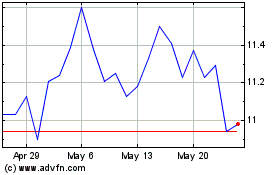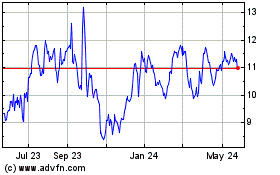Pulmovant, a Roivant (Nasdaq: ROIV) company, today announced the
presentation of data from the proof-of-concept Phase 1b ATMOS1
study during the ERS Congress in Vienna, Austria. ATMOS
(NCT03754660) evaluated mosliciguat, a potential first-in-class,
inhaled sGC activator with targeted delivery to the lungs and
once-daily administration, in PH patients.
Mosliciguat has been extensively characterized across a robust
Phase 1 program with 170 participants dosed to date, including
patients with PH in the ATMOS study, and based these data has the
potential to show differentiated efficacy, safety, and convenience.
Mosliciguat’s target, sGC, is a key enzyme in the nitric oxide (NO)
/ cyclic guanosine monophosphate (cGMP) signaling pathway that
catalyzes cGMP production leading to increased vasodilation,
reduced inflammation and apoptosis, reverse vascular remodeling,
and anti-fibrotic effects. Unlike sGC stimulators, which require
reduced heme and NO to exert their effect on sGC, mosliciguat is an
sGC activator that works independently of heme and NO. This also
allows mosliciguat to potentially retain efficacy in highly
oxidative environments typical of PH, where stimulators are
expected to lose efficacy given heme is oxidized or removed and NO
levels are depleted.
“We believe mosliciguat can transform the lives of patients
living with pulmonary hypertension, and I am excited to announce
this potential first-in-class and best-in-category therapy.
Mosliciguat has the incredibly rare advantage of potential
differentiation across three separate key areas - efficacy, safety,
and convenience in administration. We are impressed with the data
generated so far, particularly the PVR results, and we believe its
differentiated mechanism as an sGC activator can have maximal
impact on PH-ILD patients, a large population with severe disease,
high morbidity and mortality, and few treatment options,” said Matt
Gline, Roivant’s Chief Executive Officer.
ATMOS was a non-randomized, open-label, dose escalation,
proof-of-concept Phase 1b trial that assessed the efficacy, safety,
tolerability, and pharmacokinetics of mosliciguat following single
dose inhaled administration in participants aged between 18 and 80
years with World Health Organization (WHO) Group 1 PH (pulmonary
arterial hypertension (PAH)) or Group 4 PH (chronic thromboembolic
pulmonary hypertension (CTEPH)). Overall, 38 patients received
mosliciguat in this study. In the per-protocol set of patients
(N=20), mosliciguat 1.0, 2.0 and 4.0 mg doses led to mean peak
percentage reductions in PVR from baseline of -25.9%, -38.1% and
-36.3%, respectively, consistently exceeding the predefined ≥ -20%
threshold for the primary outcome. The per-protocol analysis
included the 20 patients who were nonresponsive to inhaled NO.
Notably, a similar effect on PVR was observed in the
pharmacodynamic analysis set (N=37), which included participants
both responsive and non-responsive to inhaled NO, suggesting that
mosliciguat’s novel mechanism of action may allow for broad
activity across the spectrum of PH. Single dose administration via
dry powder inhaler was well tolerated, with low rates of TEAEs
observed.
Overall, in its Phase 1 development program in 170 healthy
volunteers and PH patients, mosliciguat has shown a favorable
safety profile, dose-dependent increases in cGMP, and a 40-hour
half-life supporting convenient once-daily dosing. Mosliciguat is
unique among inhaled PH therapies, requiring just one inhalation
per day – all currently approved therapies require multiple
inhalations, multiple times per day. Mosliciguat is formulated for
delivery via DPI, providing greater convenience to patients
compared to nebulizers required for many existing inhaled PH
therapies. Direct delivery to the lungs also minimizes risk of
serious adverse effects seen with systemic vasodilators, such as
worsening of oxygenation status. In addition to greater efficacy as
evidenced by PVR in ATMOS, a generally favorable safety profile and
ease of administration support the potential differentiation for
mosliciguat.
Pulmovant will advance the clinical program to assess
mosliciguat in its global Phase 2 PHocus study in patients with
PH-ILD, a subgroup of Group 3 PH. Approximately 120 patients will
be enrolled in the study, which will start imminently. An estimated
200,000 patients across the U.S. and Europe are living with PH-ILD
and have limited or no approved treatment options. The PH-ILD
prevalence is meaningfully greater than that of PAH, representing
an attractive commercial opportunity with limited competition and
high unmet patient need.
“We have elected to initiate our global Phase 2 PHocus study in
PH-ILD because of the lack of treatment options for patients
coupled with the impressive Phase 1b results and strong biologic
rationale,” noted Drew Fromkin, Pulmovant’s Chief Executive
Officer. “PH-ILD is a devastating disease that is associated with
high morbidity and mortality as well as poor quality of life. We
are committed to making a significant difference for these patients
and have assembled a stellar team, alongside our world-class
investigators and advisors, to advance and optimize mosliciguat’s
development.”
About Pulmonary Hypertension and Interstitial Lung
Disease
Pulmonary hypertension (PH) is a progressive and debilitating
condition characterized by high blood pressure in the blood vessels
of the lungs. This elevated pressure forces the heart to work
harder to pump blood through the lungs, leading to symptoms such as
shortness of breath, fatigue, chest pain, and dizziness. The WHO
has classified PH into five groups based on their underlying
causes, symptoms, and treatment approaches. Group 3 PH is a subtype
of PH that arises from lung diseases, such as interstitial lung
disease (ILD). ILD describes a large group of diseases that cause
progressive damage to the lungs, making it difficult for patients
to breathe. Up to 200,000 patients across U.S. and Europe are
living with PH-ILD, a subset of Group 3 PH, and have limited to no
approved treatment options. Click here for more information.
About Pulmovant
Pulmovant is a clinical-stage biotechnology company developing
innovative therapies for patients suffering from pulmonary
diseases. Pulmovant’s first program, mosliciguat is designed to
provide an effective, once-daily, inhaled treatment option for
patients with pulmonary hypertension (PH). Mosliciguat is a novel,
potential first-in-class, sGC activator with a differentiated
mechanism that may have broad applicability across the PH
spectrum.
For more information, please visit
https://www.pulmovant.com.
© 2024 Pulmovant, Inc. All Rights Reserved. All trademarks are
the property of their respective owners.
_______________________________
1 ATMOS, a Proof-of-Concept trial of inhaled mosliciguat in
untreated PAH or CTEPH was presented during poster session (PS) 31,
poster number PA5238, at the European Respiratory Society Congress
on September 10, 2024, from 12:30 to 2:00 PM CET.
Roivant Sciences (NASDAQ:ROIV)
Historical Stock Chart
From Aug 2024 to Sep 2024

Roivant Sciences (NASDAQ:ROIV)
Historical Stock Chart
From Sep 2023 to Sep 2024
